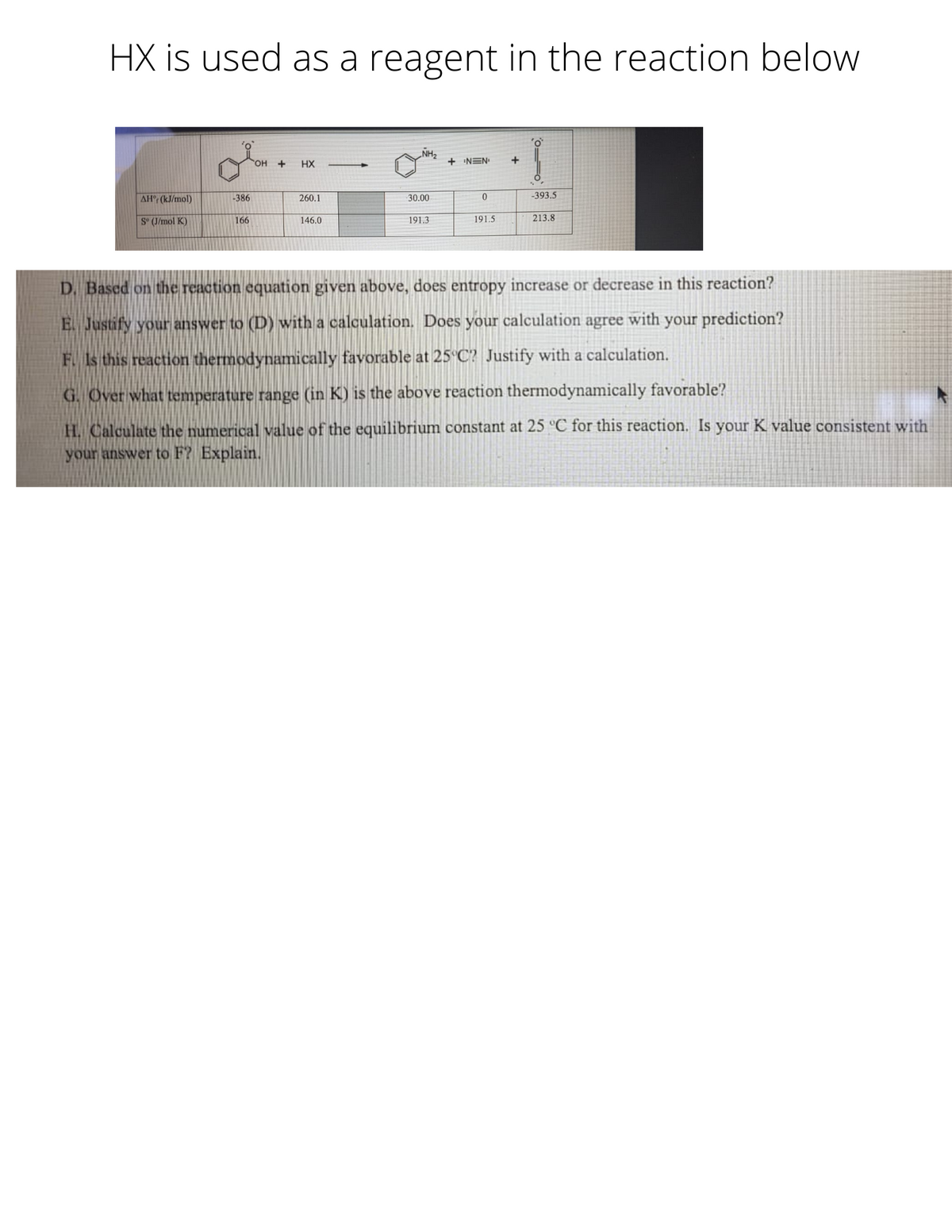NH2 OH + HX + NEN AH (kJ/mol) -386 260.1 30.00 -393.5 S (J/mol K) 166 191.3 191.5 213.8 146.0 D. Based on the reaction equation given above, does entropy increase or decrease in this reaction? E Justify your answer to (D) with a calculation. Does your calculation agree with your prediction? F. Is this reaction thermodynamically favorable at 25 C? Justify with a calculation.
NH2 OH + HX + NEN AH (kJ/mol) -386 260.1 30.00 -393.5 S (J/mol K) 166 191.3 191.5 213.8 146.0 D. Based on the reaction equation given above, does entropy increase or decrease in this reaction? E Justify your answer to (D) with a calculation. Does your calculation agree with your prediction? F. Is this reaction thermodynamically favorable at 25 C? Justify with a calculation.
Chemistry for Engineering Students
4th Edition
ISBN:9781337398909
Author:Lawrence S. Brown, Tom Holme
Publisher:Lawrence S. Brown, Tom Holme
Chapter10: Entropy And The Second Law Of Thermodynamics
Section: Chapter Questions
Problem 10.90PAE: A key component in many chemical engineering designs is the separation of mixtures of chemicals. (a)...
Related questions
Question
100%

Transcribed Image Text:HX is used as a reagent in the reaction below
NH2
OH +
HX
+ :N=N+
+
-393.5
AH (kJ/mol)
-386
260.1
30.00
S° (J/mol K)
166
146.0
191.3
191.5
213.8
D. Based on the reaction equation given above, does entropy increase or decrease in this reaction?
E. Justify your answer to (D) with a calculation. Does your calculation agree with your prediction?
F. Is this reaction thermodynamically favorable at 25 C? Justify with a calculation.
G. Over what temperature range (in K) is the above reaction thermodynamically favorable?
H. Calculate the numerical value of the equilibrium constant at 25 °C for this reaction. Is your K value consistent with
your answer to F? Explain.
Expert Solution
This question has been solved!
Explore an expertly crafted, step-by-step solution for a thorough understanding of key concepts.
Step by step
Solved in 2 steps

Knowledge Booster
Learn more about
Need a deep-dive on the concept behind this application? Look no further. Learn more about this topic, chemistry and related others by exploring similar questions and additional content below.Recommended textbooks for you

Chemistry for Engineering Students
Chemistry
ISBN:
9781337398909
Author:
Lawrence S. Brown, Tom Holme
Publisher:
Cengage Learning

Chemistry by OpenStax (2015-05-04)
Chemistry
ISBN:
9781938168390
Author:
Klaus Theopold, Richard H Langley, Paul Flowers, William R. Robinson, Mark Blaser
Publisher:
OpenStax

Chemistry: An Atoms First Approach
Chemistry
ISBN:
9781305079243
Author:
Steven S. Zumdahl, Susan A. Zumdahl
Publisher:
Cengage Learning

Chemistry for Engineering Students
Chemistry
ISBN:
9781337398909
Author:
Lawrence S. Brown, Tom Holme
Publisher:
Cengage Learning

Chemistry by OpenStax (2015-05-04)
Chemistry
ISBN:
9781938168390
Author:
Klaus Theopold, Richard H Langley, Paul Flowers, William R. Robinson, Mark Blaser
Publisher:
OpenStax

Chemistry: An Atoms First Approach
Chemistry
ISBN:
9781305079243
Author:
Steven S. Zumdahl, Susan A. Zumdahl
Publisher:
Cengage Learning


Chemistry
Chemistry
ISBN:
9781305957404
Author:
Steven S. Zumdahl, Susan A. Zumdahl, Donald J. DeCoste
Publisher:
Cengage Learning

Chemistry: The Molecular Science
Chemistry
ISBN:
9781285199047
Author:
John W. Moore, Conrad L. Stanitski
Publisher:
Cengage Learning